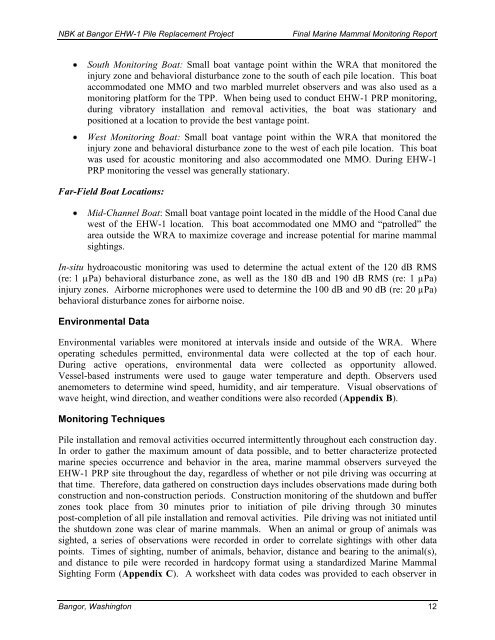Section 1 Introduction - National Marine Fisheries Service - NOAA
Section 1 Introduction - National Marine Fisheries Service - NOAA
Section 1 Introduction - National Marine Fisheries Service - NOAA
You also want an ePaper? Increase the reach of your titles
YUMPU automatically turns print PDFs into web optimized ePapers that Google loves.
NBK at Bangor EHW-1 Pile Replacement Project Final <strong>Marine</strong> Mammal Monitoring Report<br />
South Monitoring Boat: Small boat vantage point within the WRA that monitored the<br />
injury zone and behavioral disturbance zone to the south of each pile location. This boat<br />
accommodated one MMO and two marbled murrelet observers and was also used as a<br />
monitoring platform for the TPP. When being used to conduct EHW-1 PRP monitoring,<br />
during vibratory installation and removal activities, the boat was stationary and<br />
positioned at a location to provide the best vantage point.<br />
West Monitoring Boat: Small boat vantage point within the WRA that monitored the<br />
injury zone and behavioral disturbance zone to the west of each pile location. This boat<br />
was used for acoustic monitoring and also accommodated one MMO. During EHW-1<br />
PRP monitoring the vessel was generally stationary.<br />
Far-Field Boat Locations:<br />
Mid-Channel Boat: Small boat vantage point located in the middle of the Hood Canal due<br />
west of the EHW-1 location. This boat accommodated one MMO and “patrolled” the<br />
area outside the WRA to maximize coverage and increase potential for marine mammal<br />
sightings.<br />
In-situ hydroacoustic monitoring was used to determine the actual extent of the 120 dB RMS<br />
(re: 1 µPa) behavioral disturbance zone, as well as the 180 dB and 190 dB RMS (re: 1 µPa)<br />
injury zones. Airborne microphones were used to determine the 100 dB and 90 dB (re: 20 µPa)<br />
behavioral disturbance zones for airborne noise.<br />
Environmental Data<br />
Environmental variables were monitored at intervals inside and outside of the WRA. Where<br />
operating schedules permitted, environmental data were collected at the top of each hour.<br />
During active operations, environmental data were collected as opportunity allowed.<br />
Vessel-based instruments were used to gauge water temperature and depth. Observers used<br />
anemometers to determine wind speed, humidity, and air temperature. Visual observations of<br />
wave height, wind direction, and weather conditions were also recorded (Appendix B).<br />
Monitoring Techniques<br />
Pile installation and removal activities occurred intermittently throughout each construction day.<br />
In order to gather the maximum amount of data possible, and to better characterize protected<br />
marine species occurrence and behavior in the area, marine mammal observers surveyed the<br />
EHW-1 PRP site throughout the day, regardless of whether or not pile driving was occurring at<br />
that time. Therefore, data gathered on construction days includes observations made during both<br />
construction and non-construction periods. Construction monitoring of the shutdown and buffer<br />
zones took place from 30 minutes prior to initiation of pile driving through 30 minutes<br />
post-completion of all pile installation and removal activities. Pile driving was not initiated until<br />
the shutdown zone was clear of marine mammals. When an animal or group of animals was<br />
sighted, a series of observations were recorded in order to correlate sightings with other data<br />
points. Times of sighting, number of animals, behavior, distance and bearing to the animal(s),<br />
and distance to pile were recorded in hardcopy format using a standardized <strong>Marine</strong> Mammal<br />
Sighting Form (Appendix C). A worksheet with data codes was provided to each observer in<br />
Bangor, Washington 12
















